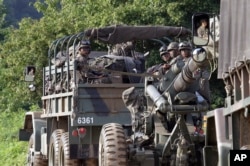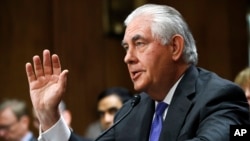In January, Donald Trump drew what appeared to be a “red line” for North Korea: testing a ballistic missile that could reach parts of the United States with a nuclear warhead.
“It won't happen!” insisted then President-elect Trump in a statement he posted on Twitter.
Except early Tuesday, it did happen, according to North Korean state television, which reported Kim Jong Un “personally observed” the test of the Hwaseong-14 intercontinental ballistic missile.
The North's claims were bolstered by the U.S. military, which tracked the missile for 37 minutes, and independent analysts, who estimated its range at 6,500 kilometers (4,000 miles) — far enough to reach Alaska, and an apparent violation of Trump's “red line” warning.
In international geopolitics, a “red line” signifies an unequivocal threat; it could also be described as “a line in the sand.” Breaking the limit set by the “red line” would incur the full fury of the state that issued the threat.
The successful test of an ICBM (generally defined as a rocket with a range of more than 5,500 kilometers, or 3,400 miles) would represent a major challenge for Trump, who has warned the U.S. is willing to act alone to stop the North Korean nuclear threat.
Ultimatum ignored
But in reality, Trump is seen as having few good options to contain the North, and there are concerns his credibility on the issue could be bruised if Pyongyang in fact blew past his Twitter ultimatum, as initial reports suggested.
“His tweet was clearly a kind of red line, and it was a mistake to draw a red line that you don't have a good ability to enforce,” said Mark Fitzpatrick, who focuses on nonproliferation at the International Institute for Strategic Studies.
Analysts have long warned that any pre-emptive attack on North Korea would be problematic, endangering not only U.S. allies such as Japan and South Korea, but also U.S. military bases in the region.
The risk of escalation has only increased as the North's nuclear and ballistic missile programs advance, and Fitzpatrick said Tuesday's test hasn't changed that calculation.
Reaction could make things worse
“It undermines credibility when red lines are not enforced,” he said. “But the bigger problem would be to take action that is terribly risky and could lead to a bad escalation.”
Diplomats' condemnation of North Korea has been swift. U.S. Secretary of State Rex Tillerson called for global action Tuesday, saying: “All nations should demonstrate to North Korea that there are consequences to their pursuit of nuclear weapons.”
In a statement that appeared to be at least partially aimed at China, the top U.S. diplomat said any country that hosts North Korean workers, or provides economic or military aid to Pyongyang, or fails to implement United Nations sanctions, “is aiding and abetting a dangerous regime.”
At the United Nations, diplomats said the Security Council would meet late Wednesday to discuss the growing crisis.
All those factors added to the international concern about how the United States would react to North Korea's launch.
Trump's shifting positions
Trump has spoken out about his distaste for North Korea's policies on many occasions, but his own positions have shifted from time to time.
Before last November's U.S. election, Trump suggested in a campaign appearance that China could possibly assassinate Kim to reduce world tensions. He later walked back that threat, and has said as recently as May that he would be “honored” to meet the North Korean leader, “under the right circumstances.”
Given Trump's unique rhetorical style and apparent willingness to quickly change positions, many caution against reading too much into any one of the president's statements, especially those he publishes on Twitter.
“I don't take President Trump's tweets as policy,” says Harry Kazianis, director of defense studies at the Center for the National Interest. “When it comes to policy issues, specifically North Korea, or anything else, you need to look at the actions, not the tweets.”
If Trump's rhetoric is left out of the equation, his North Korea strategy does, indeed, appear more traditional. It includes long-standing U.S. tactics such as expanded sanctions and strong displays of U.S. military strength.
In particular, Trump has focused much of his efforts on convincing China, North Korea's most important ally and trading partner, to apply economic and diplomatic pressure on its neighbor. Trump subsequently tweeted that Beijing's efforts have “not worked out,” but he took an optimistic turn again on Tuesday, noting on Twitter that “perhaps China will put a heavy move on North Korea and end this nonsense once and for all!”
Swift U.S., South Korean action
In the field, the U.S. Army said that American military personnel and South Korean forces conducted a combined exercise Tuesday intended to show their ability to counter “North Korea's destabilizing and unlawful actions.”
The American and South Korean forces fired tactical missiles into Seoul's territorial waters, demonstrating a “system [that] can be rapidly deployed and engaged [with] deep strike precision capability,” according to a statement issued by an Army garrison in the South Korean capital.
Senior U.S. officials have been cautious in their comments about the latest North Korean test. A review of the missile launch is ongoing, military authorities said late Tuesday.
While it's questioned whether North Korea launched a multistage ballistic missile, evidence suggested that a two-stage intercontinental ballistic missile was launched.
There are also questions about whether the North has successfully miniaturized a nuclear warhead that it could fit on such a missile, or if it has mastered the technology necessary for an ICBM to re-enter the atmosphere. Both of these are tasks are extremely difficult, even for a military that is capable of producing and firing rockets in rapid-fire fashion.
As the White House formulates its response to the North's latest provocation, some experts cautioned that Trump should not issue any ultimatums to the North that he is not prepared to back up, whether they take the form of tweets, official statements or “red lines.”
“The world sees his tweets. North Korea reads his tweets,” said Fitzpatrick of the IISS, who previously worked at the State Department for 25 years. “The tweets are there. They're a reality.”










